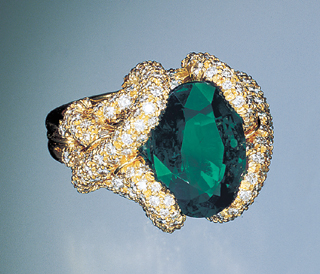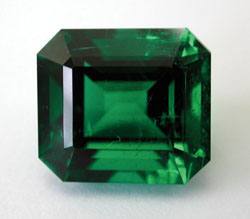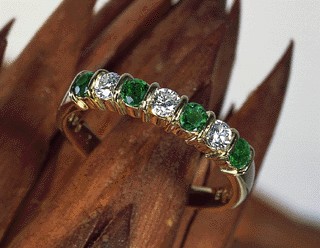A Truly Historic Gem
Emerald is
one of the most highly prized of all the gems. The name comes from the
Greek "smaragdos" which means green stone. Emerald has been treasured for at
least 4,000 years by different cultures all around the world.
Cleopatra
prized her emeralds more than any other gem. She may have dropped her pearls in her wine
for Mark Anthony but she kept her emeralds for herself! The ancient emerald mines of
Cleopatra, long a mystery, were discovered again a hundred years ago near the Red Sea.
Some tools found in the mine were dated at 1650 B.C. but no quality emeralds were found:
the mines were exhausted thousands of years ago.

Emeralds are often characterized by a
garden of inclusions of veils of tiny bubbles and other types of minerals trapped within
the stone. Under magnification, you will see all sorts of lovely patterns resembling
foliage in a garden. The inclusions are like a fingerprint, giving each emerald a distinct
personality. The extreme rarity of transparent emerald is why the finest quality emeralds
can be more valuable than diamonds. Emerald's rich green color is caused by minute traces
of chromium or vanadium. Chromium is the rare Midas element of gemstones: its presence
also gives rubies their fiery redness. Crystals of emerald grew long before human history
in metamorphic rocks, which usually restricts the size of emerald crystals, making them
very rare in large sizes.
Ancient
emeralds were taken from mines in Egypt, Austria and perhaps what is now Afghanistan. When
the Spaniards arrived on the continent of South America, they were stunned to see emeralds
finer and larger than any they had ever seen before. The Spaniards spent years searching
for the source of the fantastic green stones favored by the Incas. They found it finally
in what is today Colombia: Chivor, also known as Somondoco or "God of the green
gems," then later Muzo and Cosquez, the richest emerald mines in the planet and still
the source of the finest stones today.
Hernando
Cortes, the conquerer of Mexico, was carrying carved emeralds taken from the Aztecs in the
shapes of fish and flowers and a carved emerald bell, and an emerald the size of a man's
palm when he was shipwrecked. Many of the finest stones were lost forever. Treasure
hunters seeking wrecks of Spanish galleons are occasionally rewarded with the ultimate
treasure: emeralds lost by the conquistadores long ago.

Sources of Emerald Gems
Today,
emeralds from Colombia are easier to obtain: they are as close as the nearest jewelry
store. They are prized for a vivid saturated green like a lawn of new grass after a rain.
This color is so prized that visible inclusions are accepted in these emeralds in return
for the incomparable color.
Emerald
connoisseurs today are lucky because a relatively new find in Zambia has made emeralds
much more available on the market today. Zambian emeralds have captured a large portion of
the market because they have a rich deep color and sometimes have very few inclusions.
Zambian emeralds tend to be a slightly darker green than emeralds from Colombia and some
have a bluish tone. Fine specimens have a clear true green which deserves its place near
the top range of quality in the market, but Zambian emeralds tend to be on the small side.
Skilled
craftsmen who specialize in cutting emerald can be found in Jaipur, India and Tel-Aviv,
Israel as well as in the mining countries. Emerald is one of the most difficult gemstones
to cut because of the high value of the rough stone and the many inclusions found in
crystals. Small changes in orientation can make a large difference in the final appearance
of the gem. Emerald is most often cut in a rectangular step-cut, which is now popularly
known as the emerald cut. Smaller sizes are also found in rounds, ovals, pear shapes and
marquise cuts. You may have to look a while for an unusual shape in a larger size. Due to
their rich color, emeralds are also spectacular when cut in a smooth-domed cabochon cut.
Selecting an Emerald Gem
When
choosing an emerald, the most important value factors to consider are color and clarity.
The more vivid the green, the more valuable the emerald. There are also attractive bright
stones with a lighter green color that often make a spectacular piece of jewelry. Darker
green emeralds may also make up in rich color what they lose in brightness.
Because
emeralds are so rare without inclusions, some inclusions are expected. However, you should
look to make sure that fissures and inclusions do not go too deep into the stone so that
it might be weakened enough to break if it were hit accidentally. The fissures and
fractures that are characteristic of emerald are traditionally filled with oil to minimize
their impact. You should avoid cleaning emerald with hot soapy water or steam and never
clean an emerald in an ultrasonic cleaner because this oil could be removed or damaged,
making the fissures more visible.
A flawless, clear emerald is very rare and is usually found in only small sizes. Small to medium sized stones are often faceted in the "step" or emerald cut. The gem is also lovely when cut into a cabochon or dome shape. Sometimes emeralds are even carved. Emerald is the accepted birthstone for the month of May. It is also the anniversary gemstone for the 20th and 35th years of marriage. As a part of the normal cutting and polishing process, most emeralds are immersed in colorless oil to fill voids. Care should be taken to protect emeralds from scratches, sharp blows, household chemicals, and extreme temperature changes. Do not clean emeralds in home ultrasonic cleaning machines, as there is a potential for damage.

